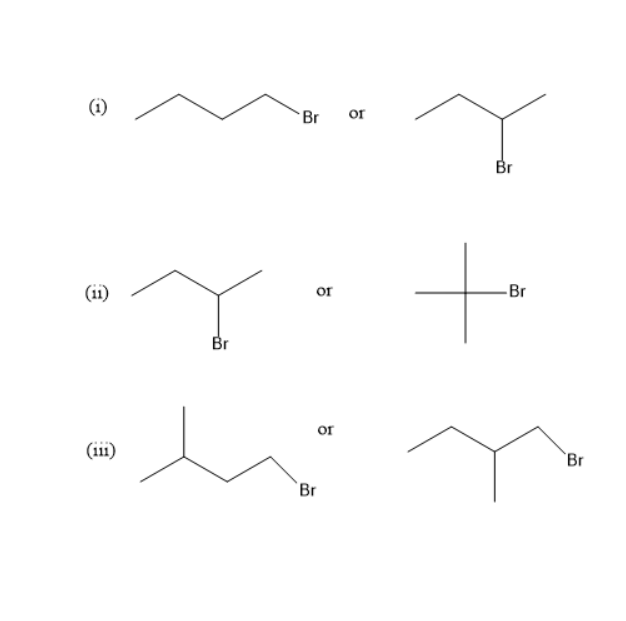Question
Question: Which alkyl halide from the following pairs would you expect to react more rapidly by an \[{S_N}2\] ...
Which alkyl halide from the following pairs would you expect to react more rapidly by an SN2 mechanism? Explain your answer.

Solution
. SN2 mechanism is a bimolecular Nucleophilic substitution reaction. It is a second order reaction whose rate depends on two species namely the nucleophile and the substrate. The reaction will take place in one step.
Complete step by step answer:
- SN2 mechanism stands for the bimolecular nucleophilic substitution reaction.
-The rate of SN2 reaction depends on the concentration of two species namely nucleophile and substrate.
-This is a second order reaction. It is a one-step mechanism.
- In SN2 mechanism the nucleophile attacks the substrate from the backside.
- A transition state containing both nucleophile and leaving group will be formed. In this transition state, the bond between nucleophile and substrate is partially formed and bond between leaving and the substrate is partially broken.
- Nucleophile approaches the substrate exactly at 180∘ to the position of the leaving group.
- Reactivity of alkyl halide in SN2 mechanisms depend on the following order:
1∘>2∘>3∘
(i) 1-Bromobutane is a primary alkyl halide while 2-Bromobutane is a secondary alkyl halide. The nucleophile which approaches 2∘ alkyl halide will be more hindered compared to 1∘alkyl halide. Therefore, 1-Bromobutane is more reactive in SN2 mechanisms than 2-Bromobutane
(ii) 2-Bromobutane is a secondary alkyl halide while 2-Bromo-2-methylpropane is a tertiary alkyl halide. Therefore, 2-Bromobutane is more reactive in SN2 mechanisms than 2-Bromo-2-methylpropane. The reason is 2-Bromo-2-methylpropane being alkyl halide is a bulky group and is very much hindered. Therefore, 2-Bromobutane is more reactive.
(iii) Both 1-Bromo-3-methylbutane and1-Bromo-2-methylbutane are 1∘ alkyl halide. In 1-Bromo-3-methylbutane, methyl group is present far away from bromine, so reactivity of 1-Bromo-3-methylbutane is greater compared to1-Bromo-2-methylbutane.
Therefore,
- In the reaction (i), 1-Bromobutane is more reactive.
- In the reaction (ii), 2-Bromobutane is more reactive.
- In the reaction (iii), 1-Bromo-3-methylbutane is more reactive.
Additional information:
| SN2 mechanism | SN1 mechanism |
|---|---|
| One-step process | Two-step process |
| Rate depends on two species i.e. nucleophile and substrate. | Rate depends on only one species i.e. substrate. |
| Reaction is favored by non-polar solvents. | Reaction is favored by polar solvents. |
| It is bimolecular. | It is unimolecular. |
| It is a second order reaction. | It is a first order reaction. |
Note: - Reactivity of different alkyl halides in SN2 mechanism is given the following order:
1∘>2∘>3∘
- Reactivity of different alkyl halides in SN1 mechanism is given the following order
3∘>2∘>1∘
